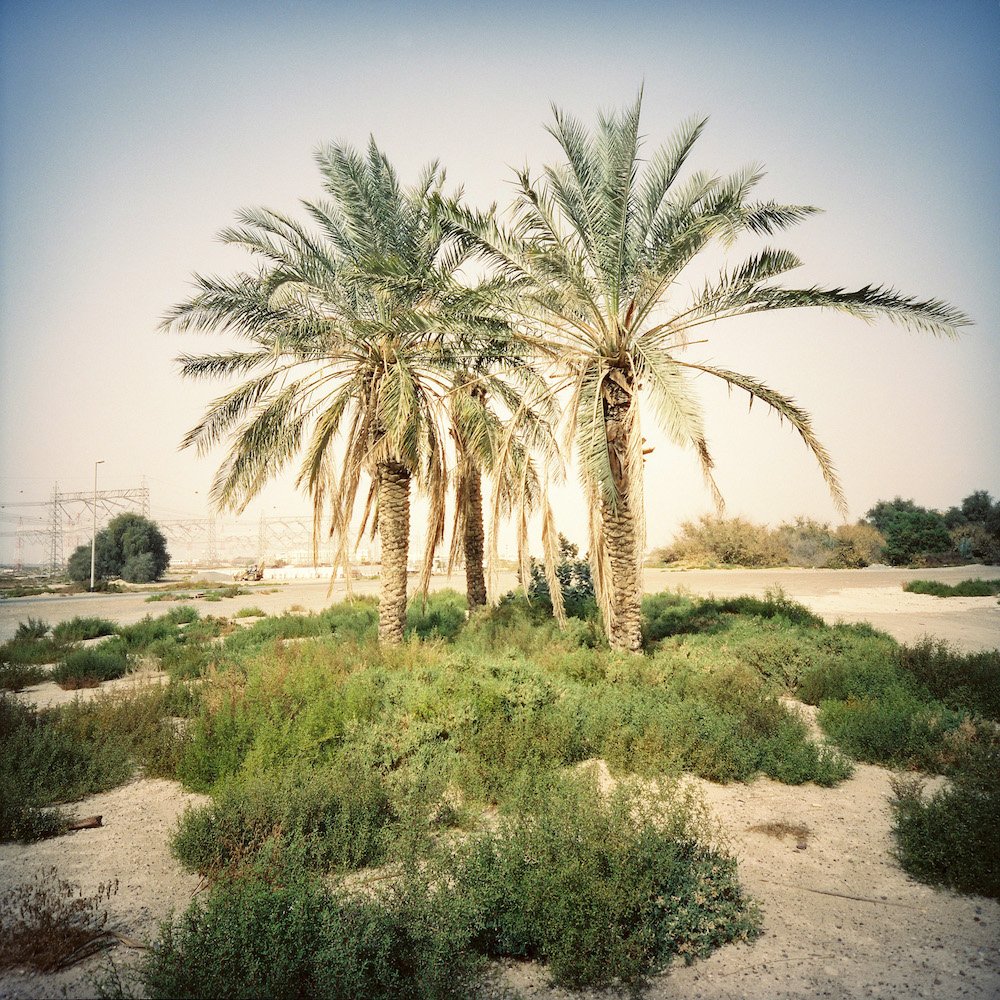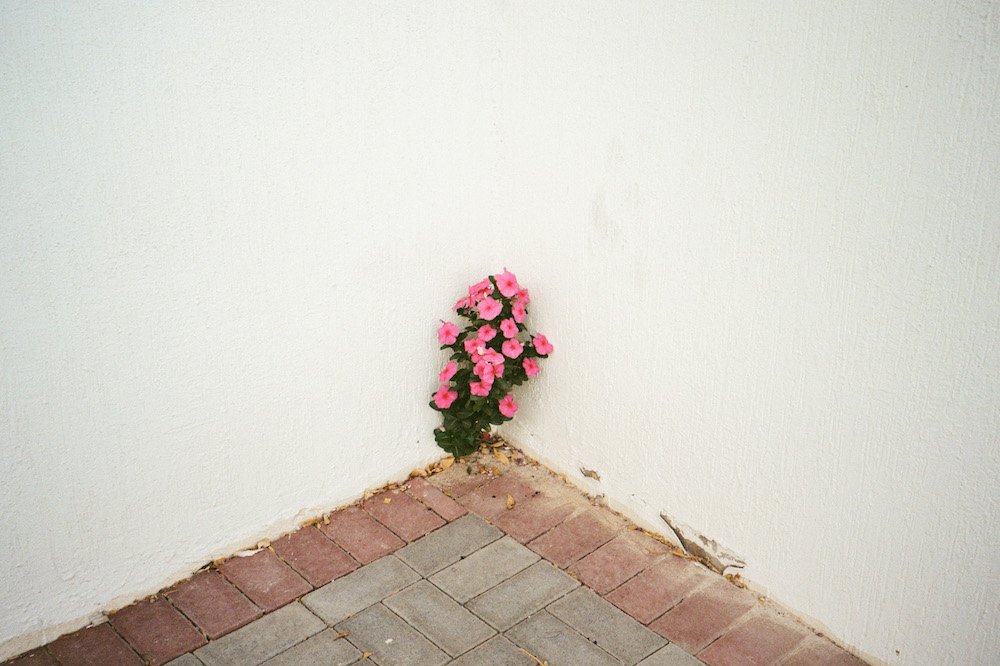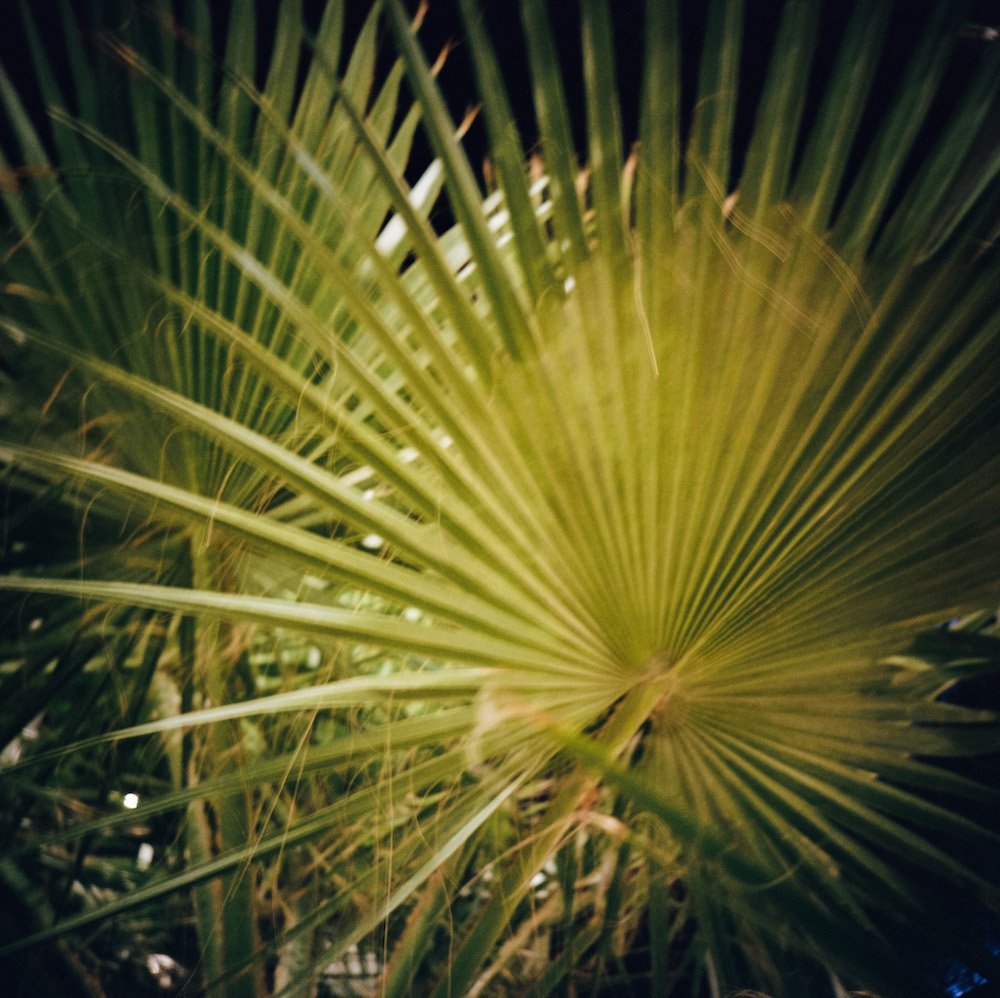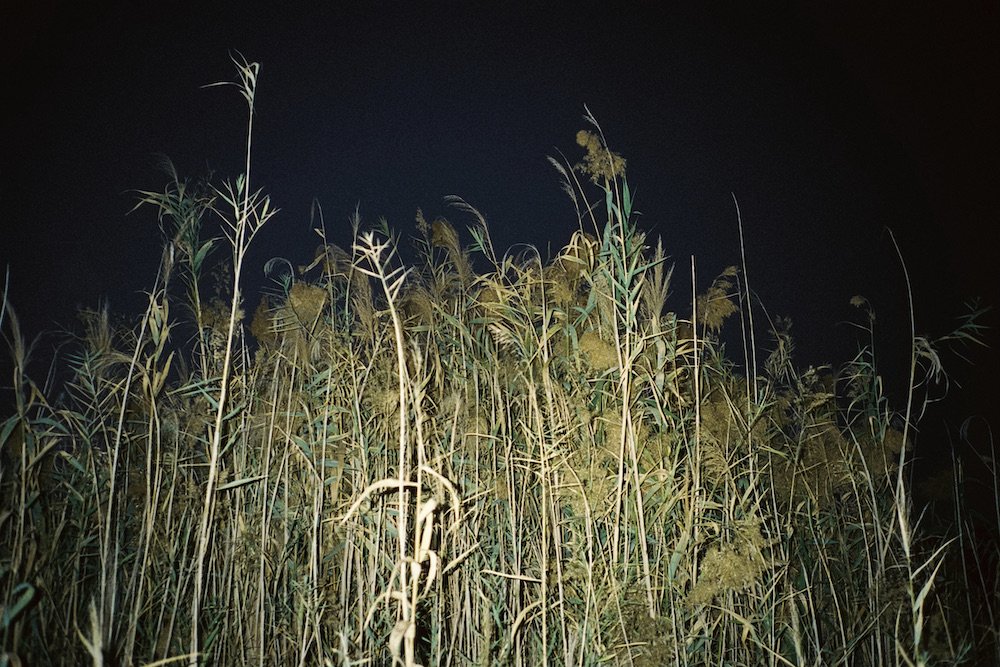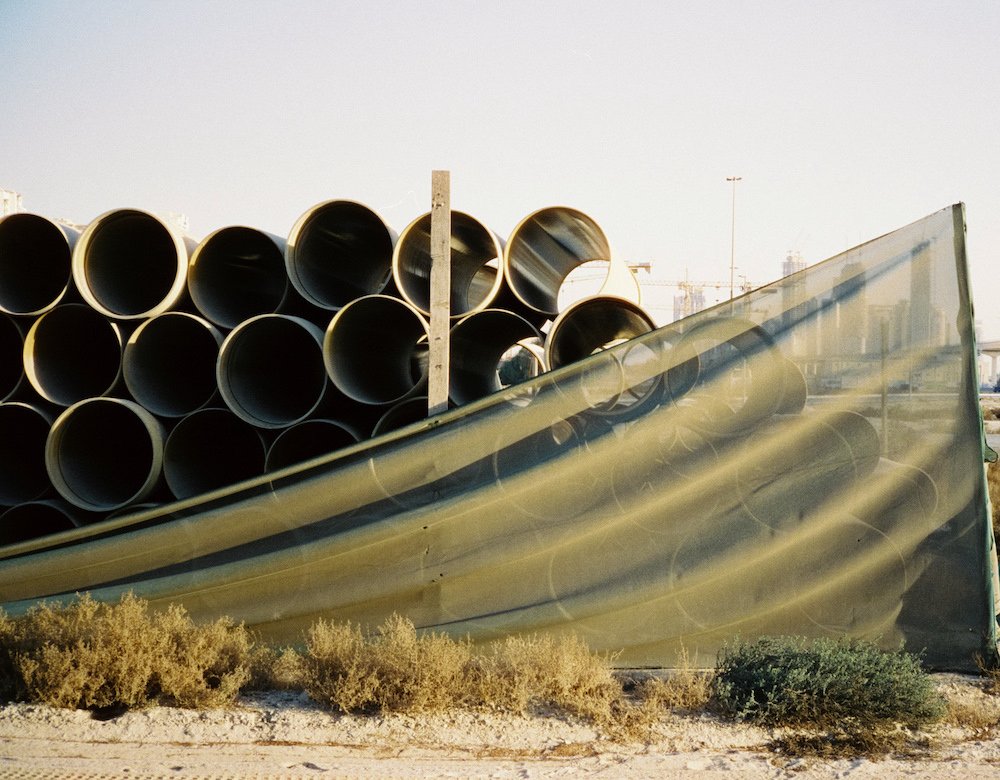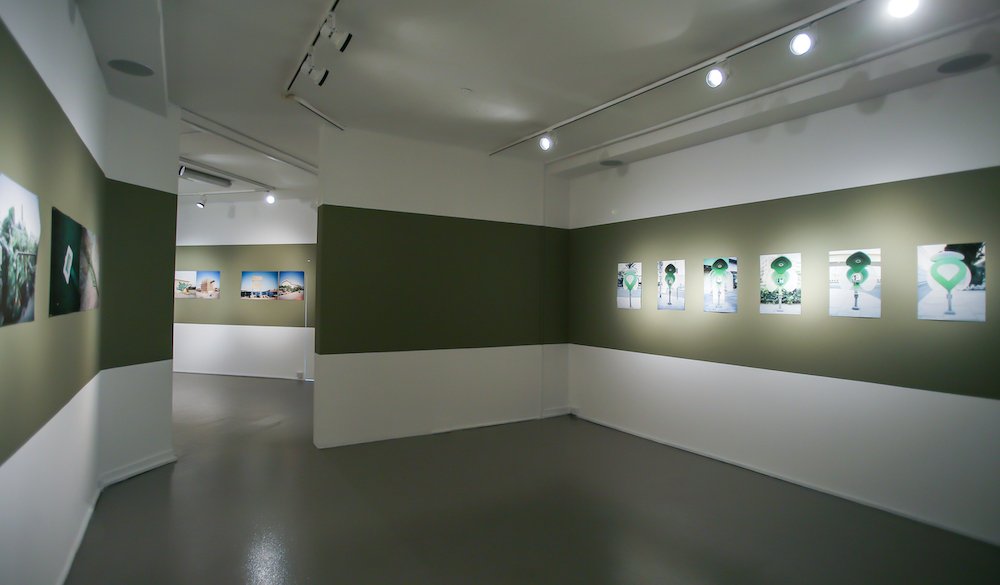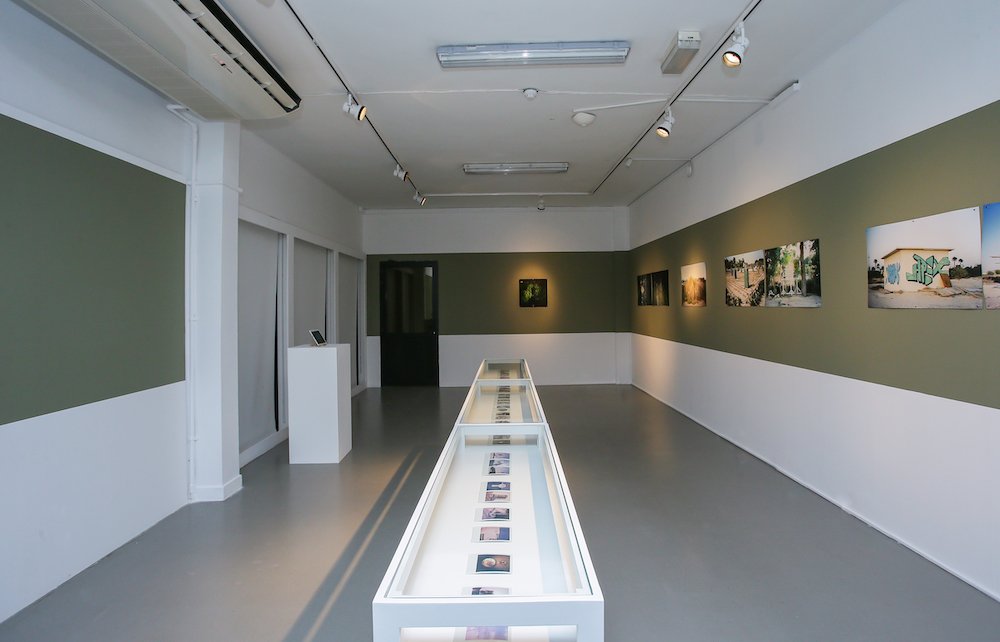Wonder Land, 2021
35mm, 120mm digital prints; Polaroids; Textile; Video
Dimensions variable
In Wonder Land, Mezaina aims to remove herself from the often-stifling familiarity by adopting an almost third-person objectivity towards the place she calls home. Moulded by the extraordinary consequences of the pandemic and their impact on the city of Dubai – social, economic and industrial – her intentional gaze brings to the foreground nuances and hitherto unnoticed elements of the urban fabric, indicative of an environment in flux; from the abandoned remnants of constant progress to the reclamatory force of nature over human endeavour. Amid the unnerving emptiness, cosmetic distractions and constructed artifices stand hollow like an abandoned fairground, devoid of meaning as the once unrelenting momentum of ambition slows to a halt.
From the blank highway billboards and the hidden pedestrian paths to the obsolete public phone booths, Mezaina considers the translation of imagery through its materiality and size.
Wonder Land is both a reflection and observation of a city that feels both alien and familiar.
This series was the result of Hind Mezaina’s participation as the 12th cohort of Tashkeel’s Critical Practice Programme and her first solo exhibition.
Text from https://tashkeel.org/exhibitions/wonder-land
Selected essays from the exhibition catalogue and installation photos are added below.
Exhibition:
2021 Tashkeel, Dubai
Press:
Al Bayan (Arabic)
Al Itihad (Arabic)
Harpers Bazaar Arabia
Khaleejesque
Khaleej Times
The National
Sayidaty (print only)
Featured in Google Arts and Culture
Presented at Sharjah Art Foundation
Exhibition Catalogue
Exhibition Posters:
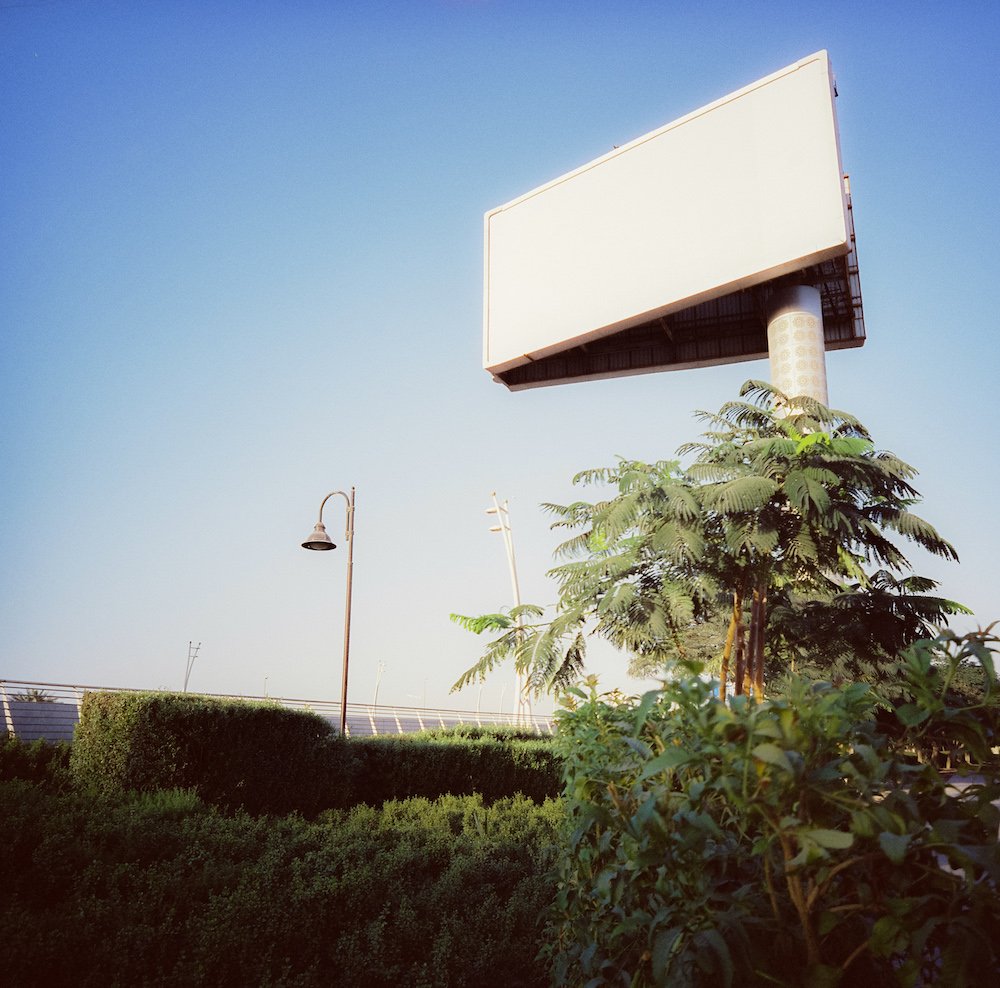
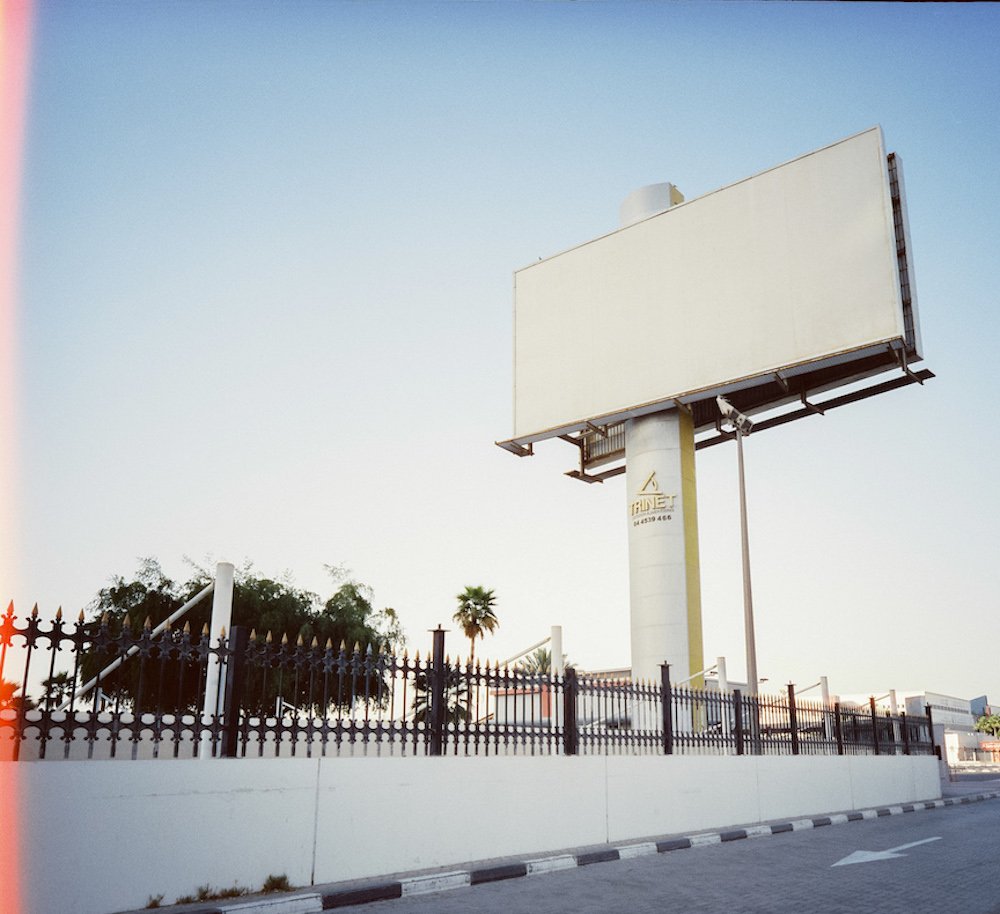
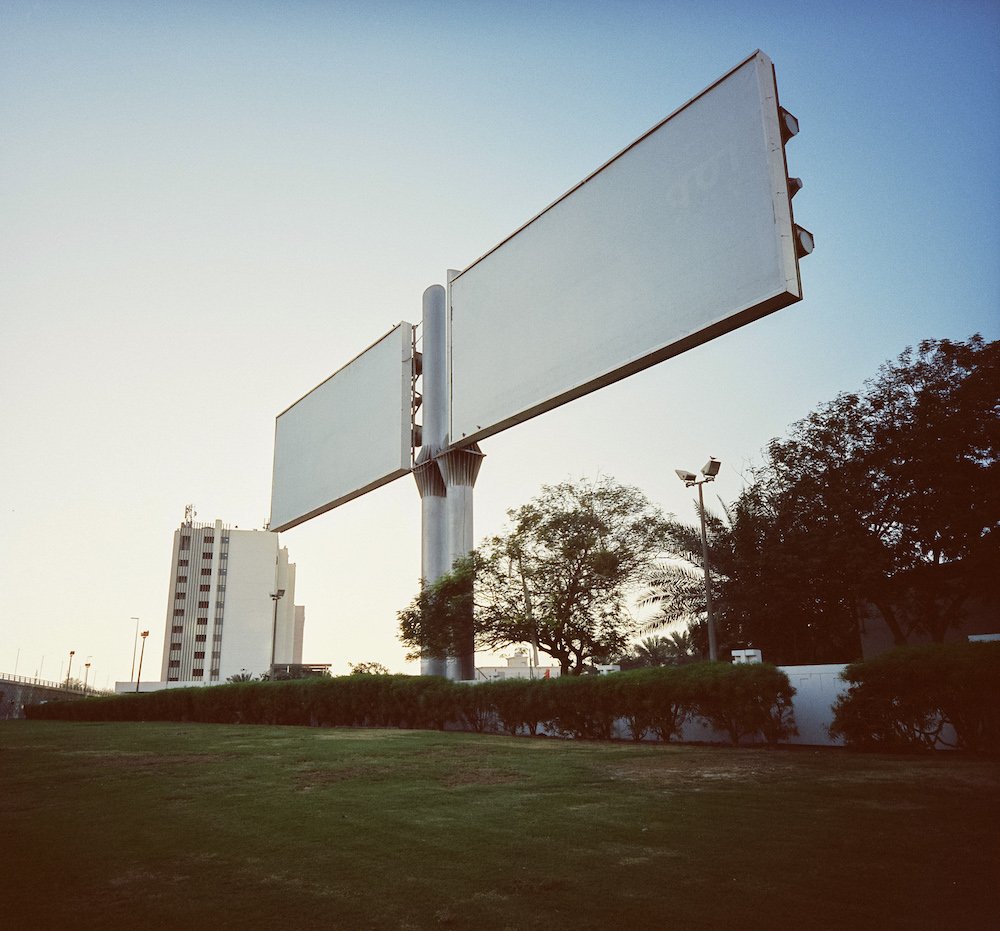
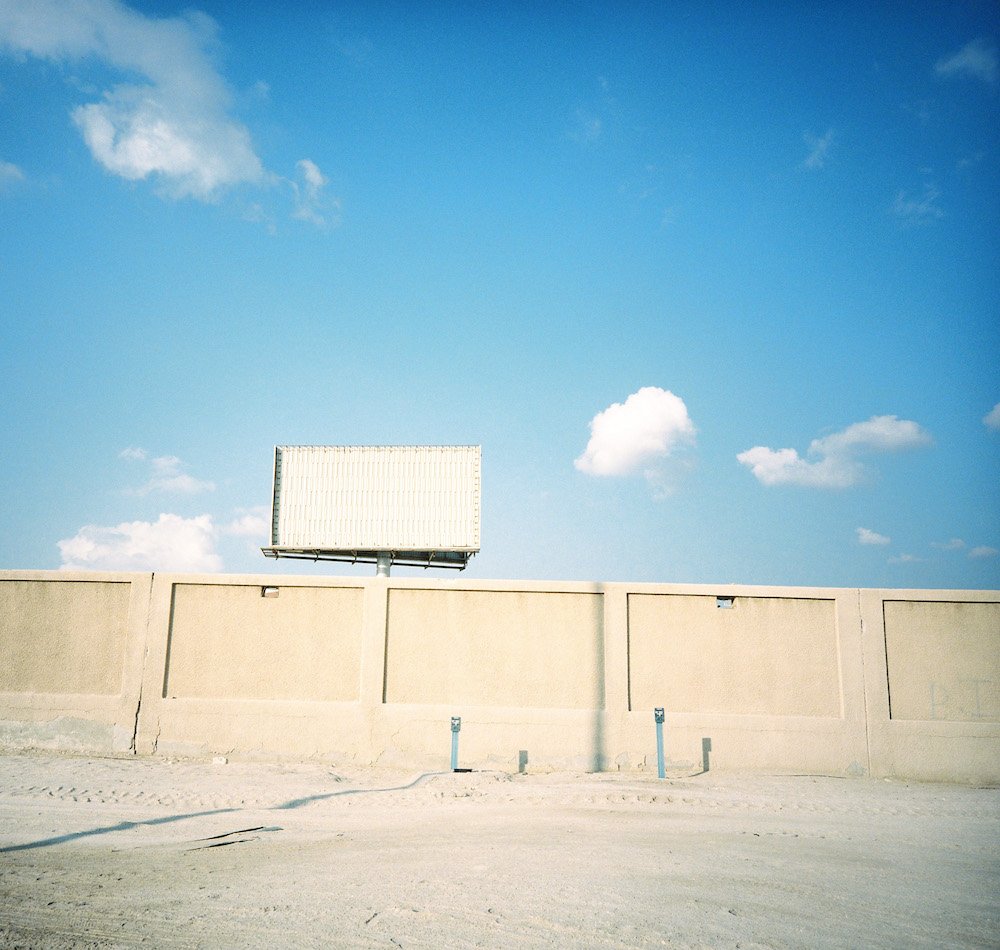
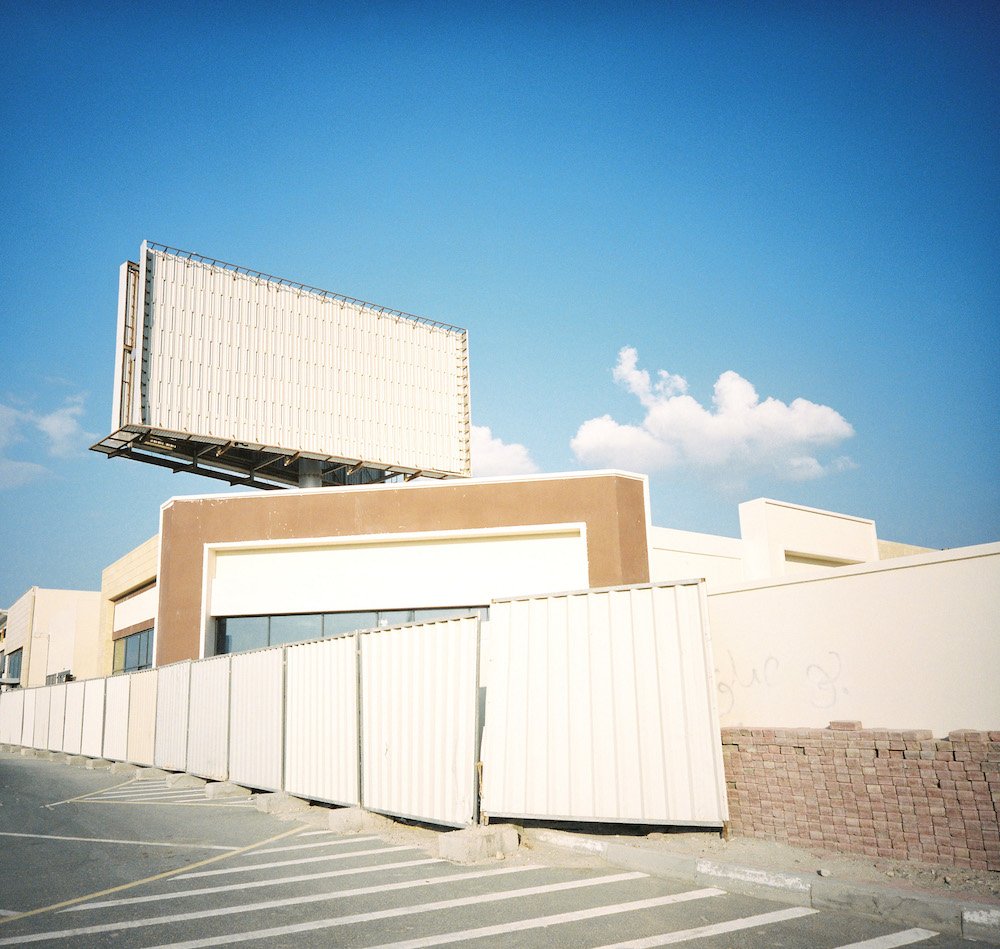
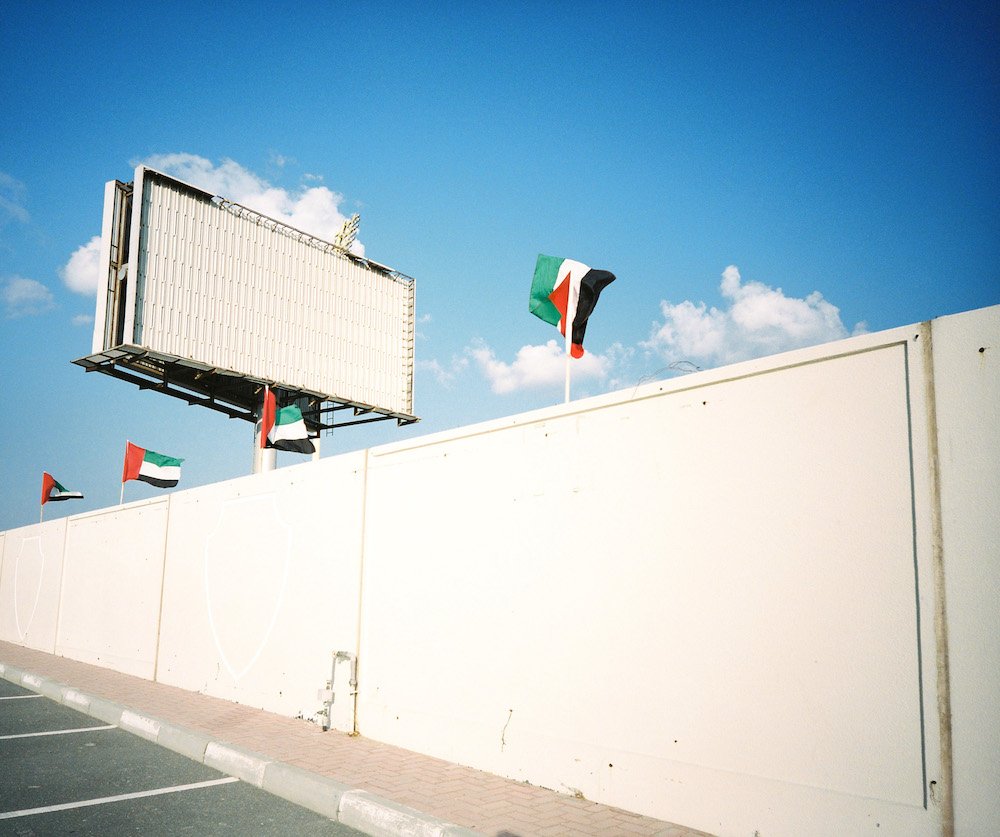
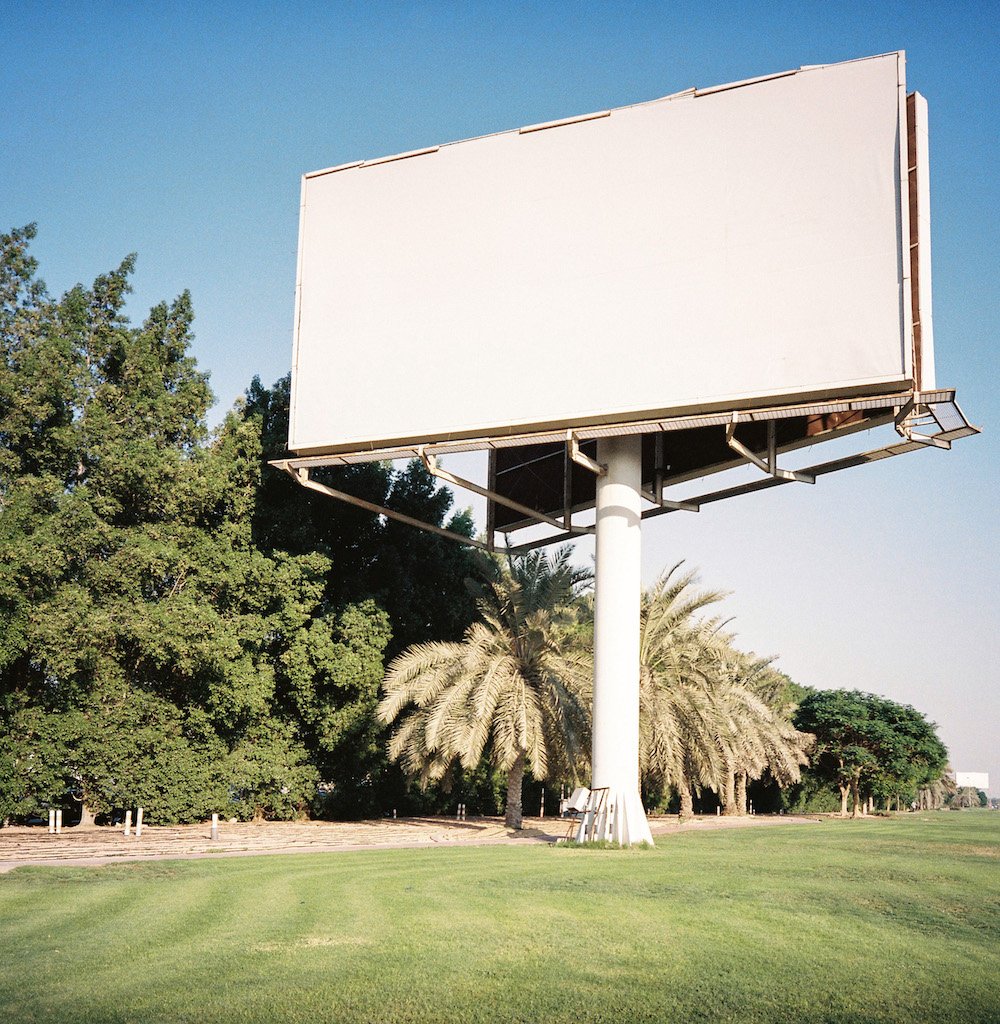

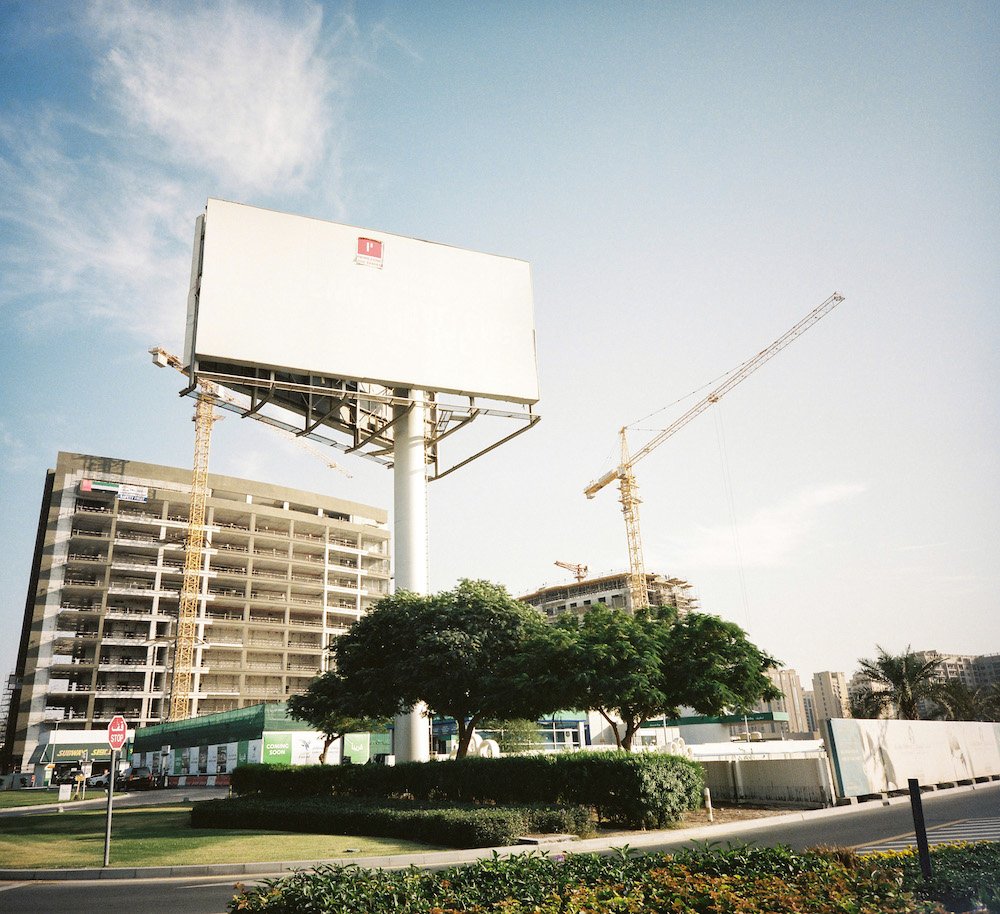
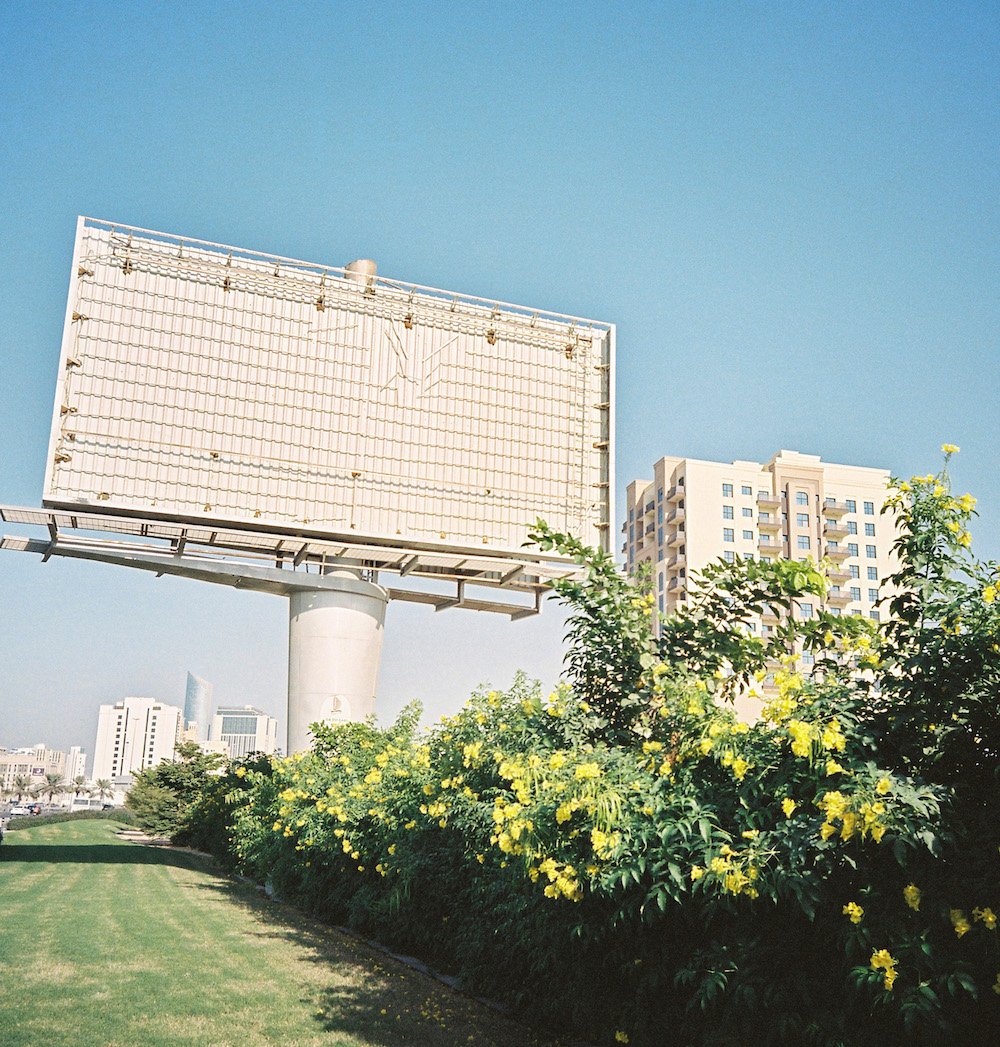
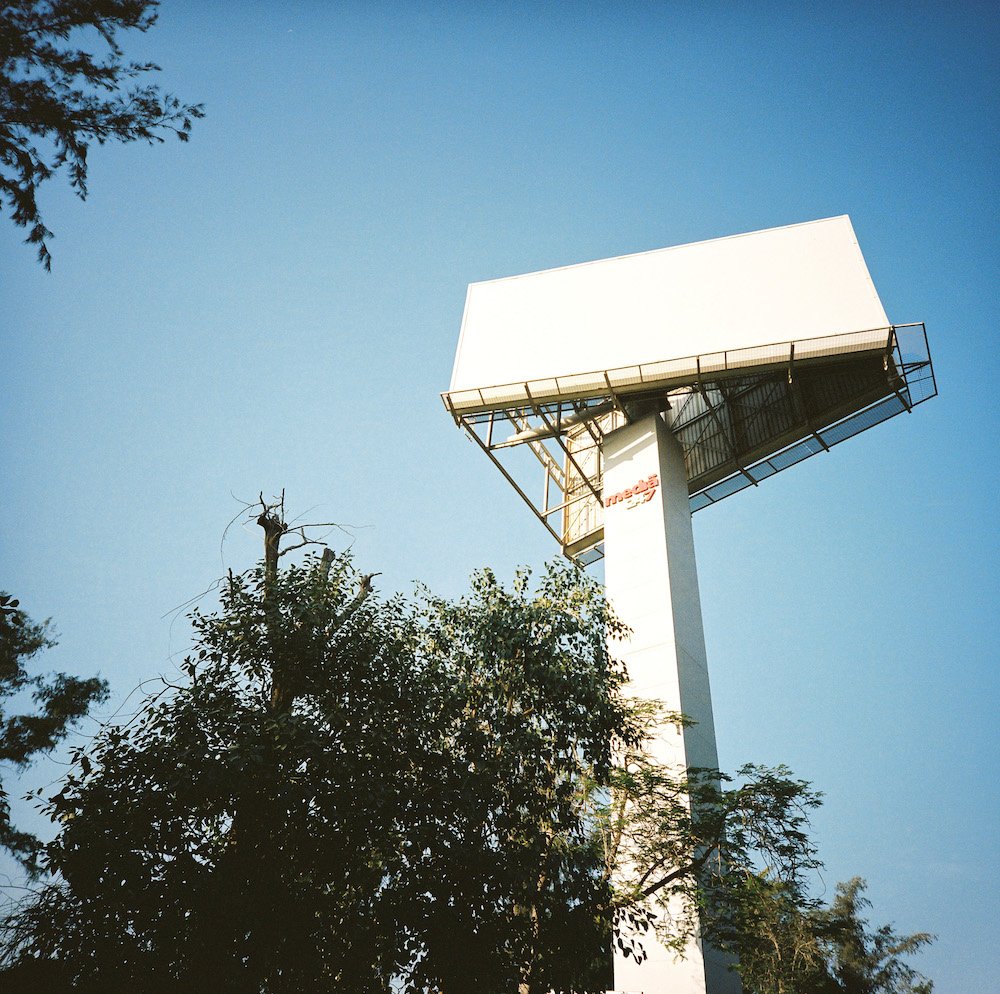
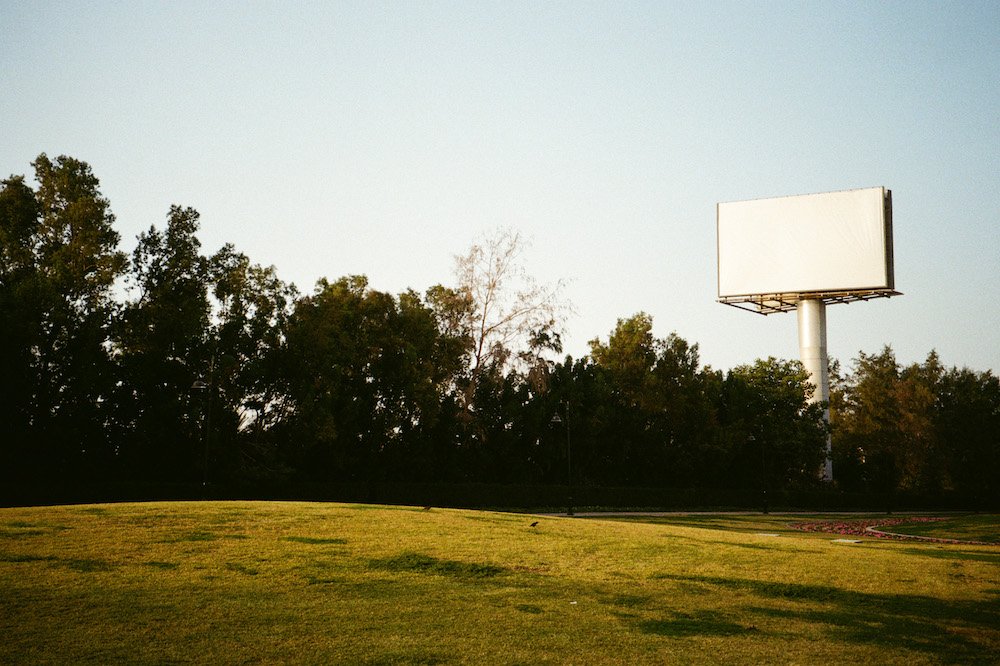
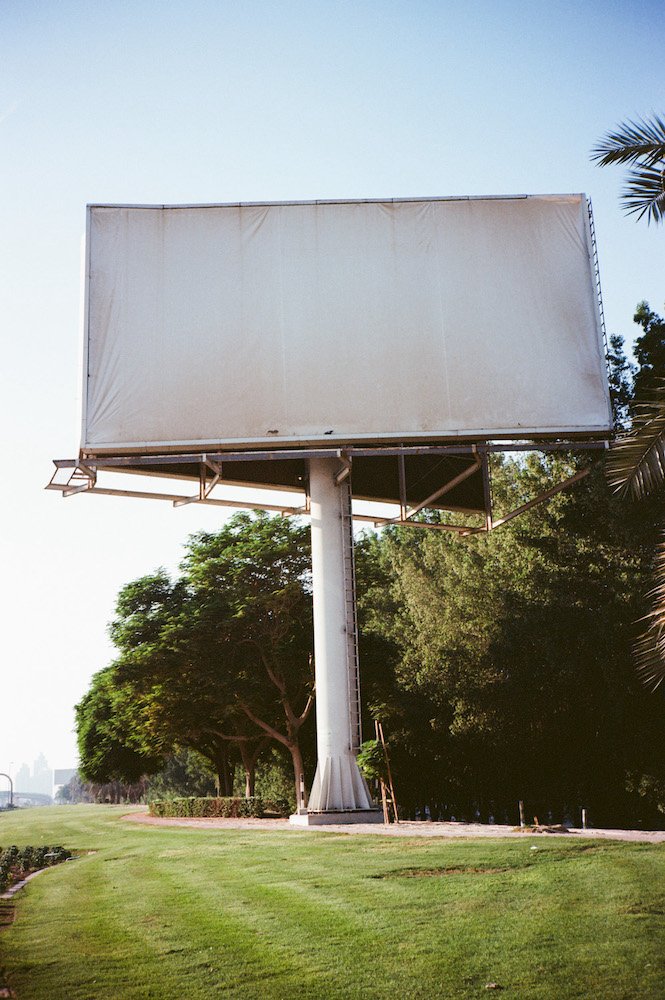

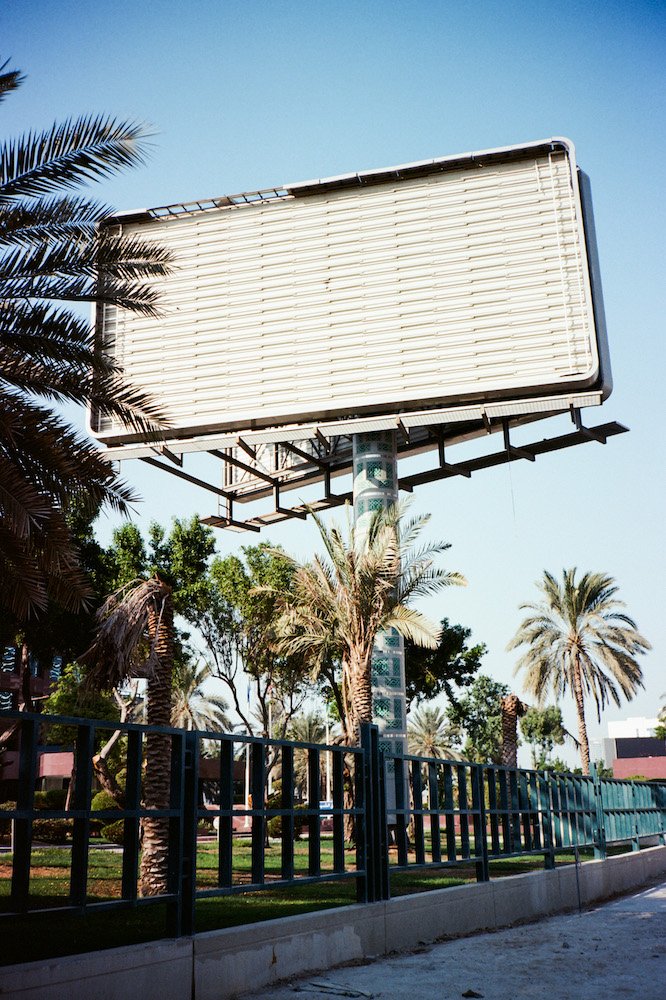
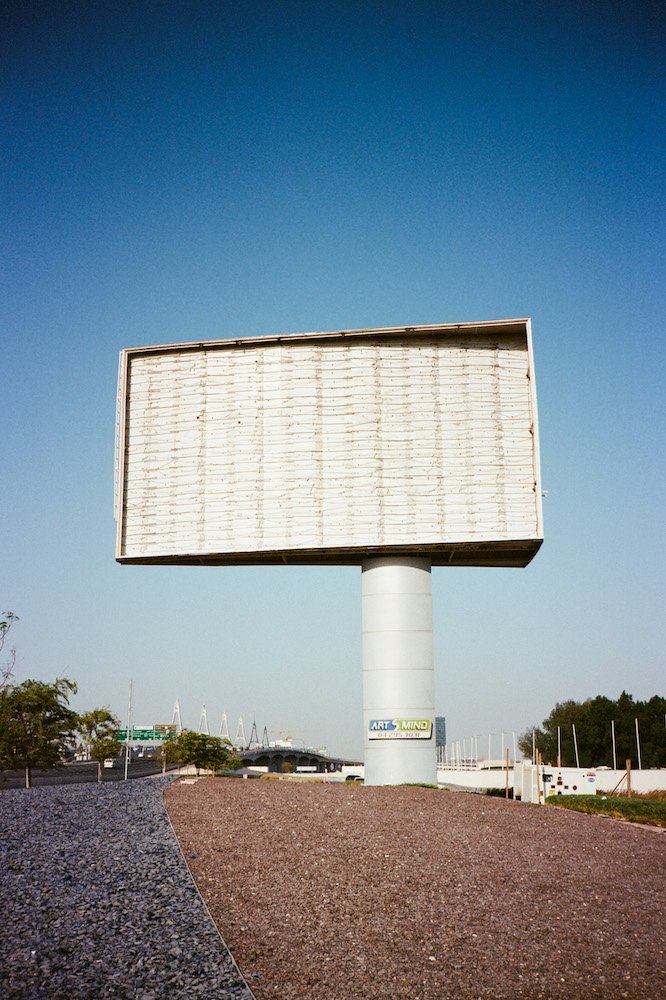
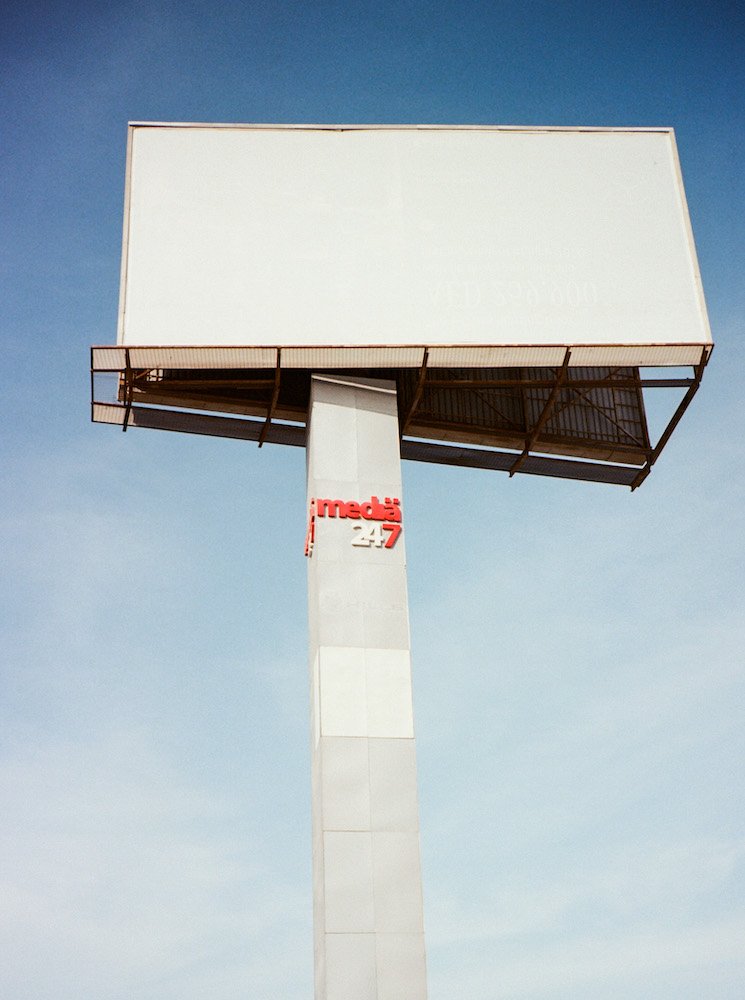
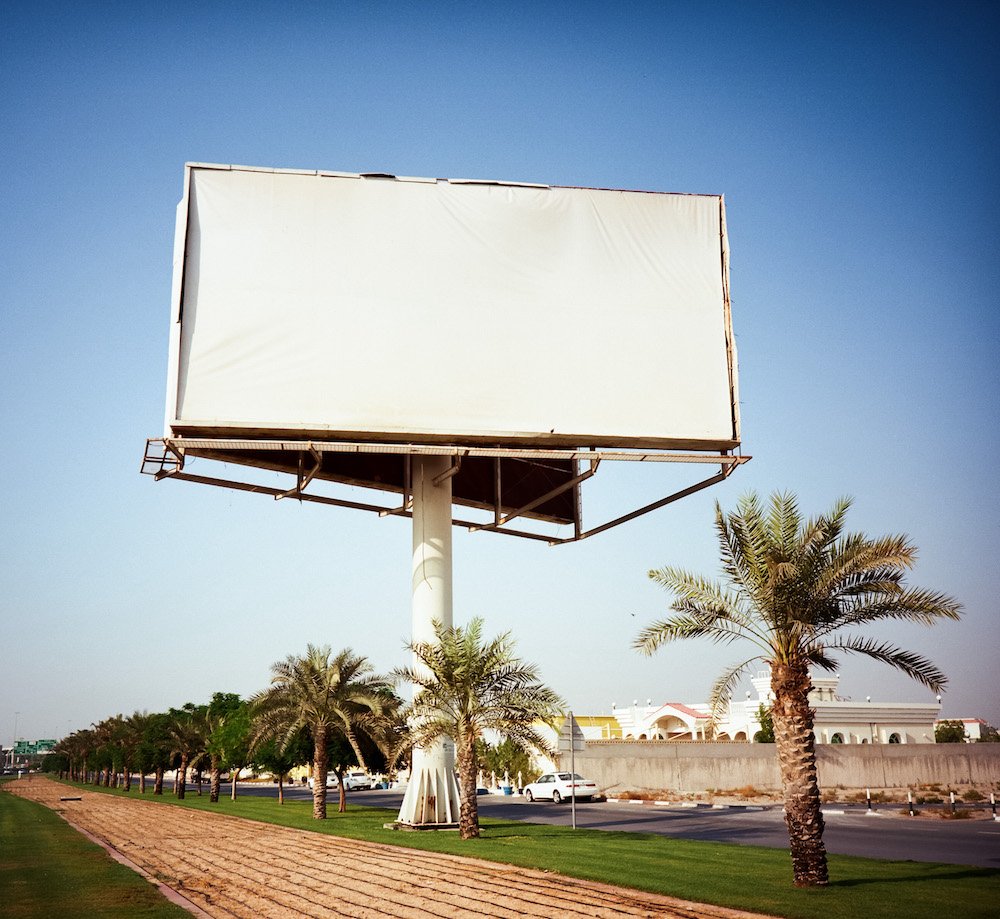

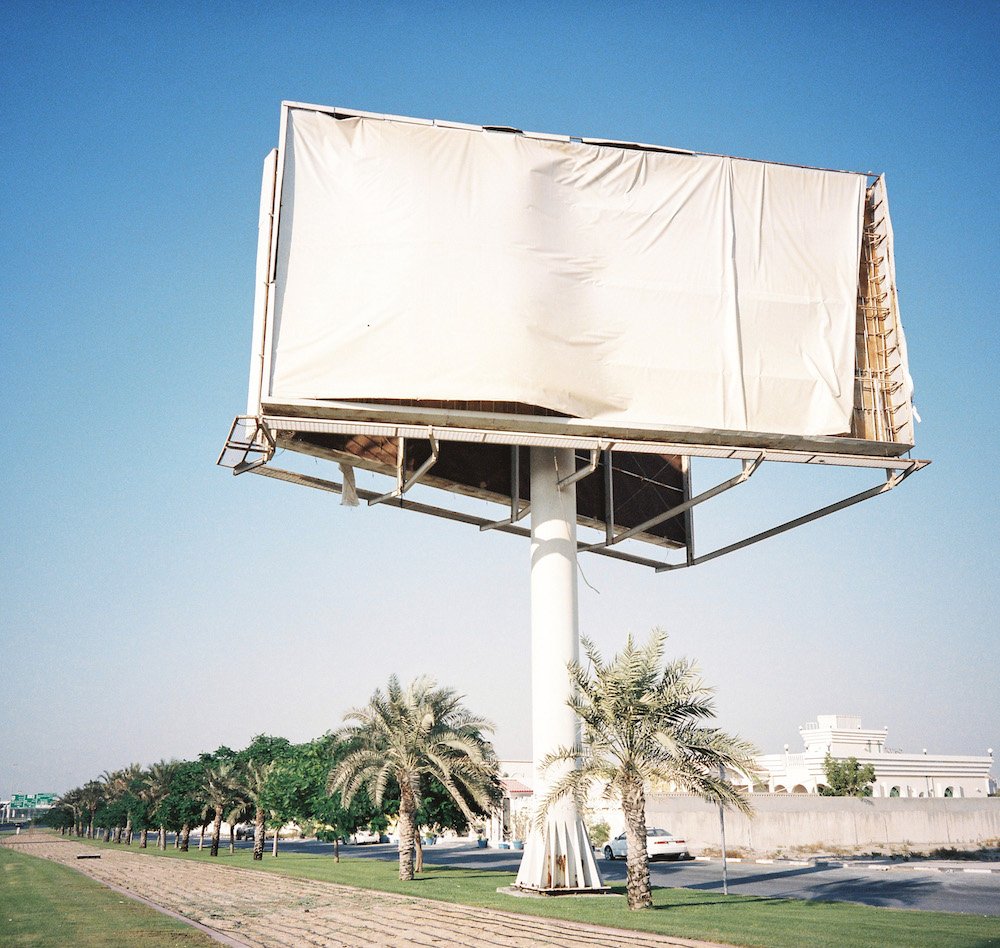
Essays from Wonder Land catalogue:
Blank billboards, phone booths and green spaces
by Hind Mezaina
Dubai always felt like a bubble to me. To experience the ‘real world’, I always had the urge to travel, spend time in other cities and to engage with them in ways I cannot in my own hometown.
When the world was in lockdown mode and borders were closed to international travel – some still closed to this date – I found myself in Dubai for the longest time in many years. Going for long drives and long walks felt like safe ways to get a sense of the city during the pandemic.
I created a border for myself, spending more time in the northern part of the city and finding myself reengaging with parts of Dubai I had not been to in a long time; occasionally (and surprisingly) finding places new to me.
The one thing that stood out the most were the blank billboards. Despite their empty facades, these tall structures expressed a lot. Outdoor advertising took a break – reasons included lack of marketing budgets, fewer people on the road to advertise to, and a tricky time to try and sell anything that feels luxurious. Yet, it was also a relief for me to see blank billboards, a decluttering of sorts, less distractions.
Taking photos of some of these blank billboards also led to me to follow foot paths. You reconnect with a city differently through walking. You find and notice things that would not be possible from a car.
I also started to take notice of the phone booths in the shape of plants, clustered around certain parts of town, that have been there for a long time. Seeing them collecting dust made me wonder how long will they remain before getting removed? During all my walks, I never found a single person using a phone booth. It is strange to now think of them as obsolete objects.
Manicured, green spaces are very visible along the roads and highways and in both commercial and private spaces and districts. Yet when you walk, you find wild, green spaces that have managed to grow on their own, without human interference. Being so used
to polished exteriors and well-groomed green spaces, finding anything ‘wild’ feels like something that needs to be preserved. But these spaces too are not safe from the constant wave of demolition – or, in this case, uprooting.
‘Wonder Land’ is a reflection and observation of a city that feels both alien and home to me.
Wonder Land
by Peggy Sue Amison
Dubai is a metropolis that lives and breathes progress; constantly reimagining and redefining itself – it is truly a land of wonder. Although its massive development is not surprising for a young city, Dubai continues to astonish and amaze with the enormity of its transformation from a landscape of shifting sands into a global centre for commerce, arts and industry.
A native of Dubai, Hind Mezaina is not easily distracted by massive facades and monumental lightshows that advertise progress in her city. Instead, she is drawn to the insignificant subtle changes that would otherwise go unnoticed. Her photographs call attention to a magnificence that incubates within the mundane.
A staccato-like forest of empty billboards appears like blank ‘post-it notes’, beautiful in their simplicity. Draped building sites seem more like backstage scenes for a theatrical production, evoking our curiosity and excitement to know what lies behind the curtain. Weeds and wildlife push up through concrete, signalling that the relentless force of nature remains ever present and a series of ‘analogue’ phone booths stand like an army of man- made bees. Their once futuristic design and function now obsolete, soon to be revised or disappeared altogether. Singularly, these images may seem quizzical but together they form a visual soundtrack that resonates a different side of the city.
Like an archaeologist, Hind digs deeper into what this flotsam and jetsam reveals about Dubai. She carefully considers how she will translate her imagery through its materiality and size. The photographs of billboards are purposefully placed directly on the wall of
the gallery to respond to the temporary nature of their source. Polaroids are contained
in glass vitrines to allow them to resonate like grace notes, accentuating their minute details and elevating them into precious artifacts. In this way, the artist creates a surprising hierarchy that provokes us to think deeper about the temporal nature of this everchanging metropolis and provide a platform for further discourse.
Peggy Sue Amison is the Artistic Director of East Wing in Dubai. As a curator, writer, producer and photographic consultant, Peggy Sue also collaborates with numerous emerging and established photographers, festivals and publications internationally. Before her position at East Wing, Peggy Sue was the Artistic Director of Sirius Arts Centre in Ireland (2001 – 2014) and a Board Member for the Belfast Photography Festival in Northern Ireland (2012 to present).
City Marketing, Flo Rida and Desert Lakes
An email exchange between Hind Mezaina and Todd Reisz during April 2021.
From: Hind Mezaina
To: Todd Reisz
Date: 10 Apr 2021, 13:48
Dear Todd
I’m both nervous and curious to see how this ‘email conversation’ will pan out. Knowing this email discussion will be published, a part of me feels I have to be careful with what we say, but I hope we both feel free and spontaneous in our replies to each other, and for the readers.
I’d like to start our conversation about the five paid for ‘articles’ in the Telegraph about Dubai, published on April 1, all “Paid for by Dubai”, i.e. paid for by Visit Dubai which is managed by Dubai’s Department of Tourism & Commerce Marketing.
I’m always bothered when I see sponsored articles promoting culture in Dubai, because it’s either publications paying writers, usually the parachuting journalist type, to write Dubai bashing articles or Dubai has to pay to tell the world it is a city of culture and a desirable destination for holidays or to live in.
Does Dubai lead the way in this kind of city marketing?
From: Todd Reisz
To: Hind Mezaina
Date: 10 Apr 2021, 21:06
Hey Hind,
Let’s see where it takes us.
It’s true, we didn’t really talk about that Telegraph campaign. Don’t forget its whole delirious 7-day itinerary that included eating bad food at high altitude (turbulence plus orange juice) and ziplining across Dubai Marina. As to the mama kangaroo–style skydiving, I always find it endearing how a paying customer cuddles up with a professional skydiver to make the jump. Remember when Flo Rida cuddled up with a pro for a video? So cute.
I’d be curious how you have reacted to the whole marketing effort. Imean, I know it doesn’t sit well with you, but I’d like to hear exactly why. For some reason, I sometimes like to play the devil’s advocate to your position. Maybe it’s because, while I do have some attachments to Dubai, I think I cut it more slack because I don’t live there. It’s also my tendency to respond from a historical lens since I probably know about the Dubai of the 1960s and 1970s more than of the 2020s. Well, not personally, but by following a history of pitches and aspirations. What I mean here is that as early as the 1960s, there were ad campaigns for Dubai, in British and US newspapers. And sometimes it wasn’t so easy in these pages to distinguish advertising from “friendly” reporting. So, I think it’s fair to say that Dubai was one of the first cities presented so expressively ambitious in this way. Nowadays, you turn on CNN and there are “Come visit [fill in the blank]” commercials every five minutes.
And, while I think one point you might make is that culture can seem to be something more marketed or exploited than, say, enriched by efforts like these, I guess I’d ask you to consider that what I remember of these articles is that they are asking your standard, uninformed tourist to see something that is good about Dubai. Was there an article on one of those fantasy bedouin dinners? I don’t recall. But there was for example, coverage of Jameel Arts Centre, which is great. It’s free. And it has helped shape the cultural landscape. And if there’s a food tour guide who’s challenging well-paying tourists to eat somewhere besides some dumb franchise joint of a televised chef, then isn’t that a good thing? Emirates, the airlines, I recall featured someone’s “favorite restaurant” Ravi several years back; I think it was after their video went viral that the Pakistani cafe invested in suburban lawn furniture to replace its white plastic chairs. So there is a risk, but I do get the sense that the sponsors this time were highlighting aspects about the city that I do love. But there are more things that need a focus: how about Tashkeel, Ishara Art Foundation, and Global Village?
So tell me how you responded.
From: Hind Mezaina
To: Todd Reisz
Date: 11 Apr 2021, 19:28
I’ve not seen the Flo Rida video in a while, so I looked it up to see how it might help with my response to you, and I came across another Flo Rida video titled “Zillionaire [Official Dubai Version]”. It starts with “ONCE UPON A TIME A ZILLIONAIRE IN DUBAI...” and it features fast cars, camels, exotic pets, Burj Al Arab Ski Dubai, Flo Rida dressed as a “sheikh”. Looks like something sponsored by a tourism board. Quaint.
I think what upsets me is that when the positive side of Dubai is written about, it’s usually ‘content’ that’s paid for, i.e. we have to pay to tell the world we have good things in this city. It’s rare to see reporting about
the same space and initiatives you mention without it feeling like a bribe job. I agree at least it’s no longer the dune bashing and desert bbq with a belly dancer experience that Dubai is trying to promote. I also was irked seeing some of the people featured in Visit Dubai paid articles promoting them as ‘articles’ and saying they’re featured in The Telegraph, and people congratulating them. I kept wondering did no one else notice these are basically just ads in the form of articles?
The word authenticity comes to mind, and I just have issues when paid for publicity gets treated as journalism. But I also know journalism and traditional media are going through a slow death, we even have to question if photos are real or not, now more than ever, so perhaps it’s inevitable that the only way one can report on something real is by having someone or some entity pay for it.
Speaking of real and fake photos, did you see the outrage last night on Twitter about an article in Vice about this guy who colourised photos of victims of the Khmer Rouge genocide and adding smiles to their faces. It’s gross. And I guess Vice does it for clicks and ethics doesn’t matter. Makes me wonder what kind of rewriting of history would happen about a place like Dubai. Not that one has to look into the future, as we see it in the present too. So a rewriting of a rewriting!
I had two friends visiting Dubai this past week, cinephile friends, so we went to the cinema a couple of times, but we also went out to eat at places they’d not heard of before and aren’t listed as must visit spots in the usual Dubai listicles. I was glad there are still spots like that in Dubai, and during the past year of this damned pandemic, I was surprised to find new spots (beach, walking paths, cafes, restaurants) in my part of town that I hadn’t been to before. I selfishly don’t flaunt them on social media, because I want them to remain known to only people who come across them on their own. I know this is very anti-marketing. Maybe I just want people to put in a bit more effort to know and understand this place.
There’s a line in the film The Last Black Man in San Francisco, “You don’t get to hate San Francisco...You don’t get to hate it unless you love it.” I feel that way about Dubai.
From: Todd Reisz
To: Hind Mezaina
Date: 13 Apr 2021, 20:50
Hi Hind,
Yeah, I’d give anything to read all those dry contractual agreements that brought the Flo Rida & production machine to Dubai.
I know what you’re saying about content. That’s just about everywhere though. I don’t gather a lot of people read the Telegraph. Getting featured there isn’t going to bring you a legacy. To me what’s so striking is that the tabloid-like paper has, in the past, provided a healthy supply of Dubai-bashing articles. I recall one that enacted a future scenario where Dubai authorities would have to take down skyscrapers. It was based on a boring consultant report about a downturn in the real estate market; but leave it to the Telegraph to sensationalize downturn into apocalypse.
It’s worth looking at it from the other angle too: why do news sites and other media outlets look at Dubai in a certain way. Either a site of some capitalist horror show or a honeypot. When I was first looking for a publisher for my urban history of Dubai, I got quick, positive responses from two well-known British publishers. They called the topic relevant, necessary. They both agreed to see me. Both talks ended when I said I wouldn’t bring money from the Gulf to publish it. One was more explicit than the other, but it’s not difficult for me to conclude that I was seen only as a potential source of cash, not a writer. That’s why, in the end, I went with an academic publisher. I thought it essential to make clear in every way possible that this was no sponsored work.
Authenticity, is such a slippery topic. It doesn’t exist anywhere, so please don’t expect places in Dubai to reach an unreachable level. Just looking at the cultural calendar of Dubai, I so prefer it to what’s going on in Amsterdam. I remember once a neighbor of mine asking me how I
can stand Dubai, since there was no culture there. He mentioned how Amsterdam was full of museums. I asked him if he ever went inside these museums. His response was something like, “No, but it means something to me that they are there if I want to visit.” What kind of answer is that? Don’t get me wrong there’s so much I love about, say, the Rijksmuseum. But it’s also fraught with tainted history.
I’m glad to hear you quoting that film. It’s kind of true though, San Francisco just isn’t worth hating!
Speaking of photoshopping the future, have you seen the story about Dubai signing the first deals for a fleet of driverless taxis? What do you think?
From: Hind Mezaina
To: Todd Reisz
Date: 17 Apr 2021, 21:26
Dubai, a capitalist horror show or a honeypot - it really is mostly seen as a city of one of two extremes and I wish I had an answer to why media outlets look at this place in a certain way, would save me having to think about it often.
I’m glad you found a way to publish your book without having to feel like it’s sponsored by anyone associated with this region. I go back to the word ‘authenticity’, i.e. it’s a book based on your hard work and research and not appeasing any local entity to get published or part of marketing and PR machine that’s so normalised here.
Your neighbour’s comment is weird and it’s always people that make these kinds of comments that are the ones that least engage with actual culture. Also, the idea that culture is just grand museums drives me mad. But I disagree with your comment about the cultural calendar of Dubai vs Amsterdam. I’m usually looking forward to flying out of Dubai to seek out culture that feeds me mentally, satisfies me emotionally, both of which I find lacking here most of the year. And it’s just not about museums, it’s also about being in walkable cities, enjoying the change of seasons and just simply enjoying public spaces that feel accessible to everyone.
Not being able to travel since March 2019 has been quite challenging, and I know it’s an extremely first world problem considering it’s a pandemic, but it has at least made me seek out spaces in Dubai I normally wouldn’t have had time to do in the past.
The driverless taxis makes me think of an erasure of a labour force and wonder who else is next. The drive to automate and digitise services, especially government services over the past few years, and fast tracked to an extent since the pandemic makes me think of how many people are not being catered to. Not everyone has smart phones, not everyone is savvy with digital services and it’s as if the city wants to cater to young, affluent digital natives and everyone else is made to feel alienated. Even the real estate spam calls are now recorded messages, which makes me miss saying “sorry, thanks but I’m not interested” instead of just hanging up on a recorded message.
But forget the driverless cars and flying taxis, I thought I’d be able to hyperloop to Abu Dhabi and back by now.
From: Todd Reisz
To: Hind Mezaina
Date: 21 Apr 2021, 19:38
Hi Hind,
Maybe I should have said cultural planning. But, yes, as you state culture has a broader and deeper meaning, even in the shape of cities. As someone who lives smack in the middle of 17th-century Amsterdam, I have access to roadways built for horse carriages, which have converted just fine to bike paths and offer a headache to anyone who dares to navigate them with SUVs. And the canal outside my window, once a public toilet and rancid dumpster, is now a gleaming pathway for suburbanites’ weekend boats and the brigade of ships that cart tourists around. Driverless taxis will come here last, I imagine and hope.
My city is walkable, but its flame is blown out. The pandemic has revealed just how much had been given over to an industry called tourism. I can walk my streets, but I have to get on a bike to find a decent coffee and a restaurant. Sometimes, when the tourists were here, I developed a bastion mentality—I didn’t want to go out there. I never drive here, that’s a luxury, and I shouldn’t complain about the bike ride to get a coffee. But this is no “urban village.” There are parts of Amsterdam that might meet your ideal, but they aren’t the places most people imagine when they think of Amsterdam.
I agree with you that Dubai’s driverless taxis are part of a campaign to reduce a certain kind of labor force. I recall reading Financial Times articles from the 90s about how Dubai was such a great place for your business because of the cheap labor. And while it’s not the industrial kind of labor today, there’s certainly the “service industries” that persists on that model. And I imagine it won’t be ending soon. Dubai sells a bargain, even to the wealthy. We’ve all seen Europeans arrive to play richer than they are at home, handling lobby employees like house staff.
Oh, the poor, dumb Hyperloop. You know those sneeze-flow simulations that have taken over the internet? I’d love to see one applied to those bullet-thin Hyperloop interiors. Sois béni !
From: Todd Reisz
To: Hind Mezaina
Date: 24 Apr 2021, 13:20
Dear Hind
I couldn’t wait for a reply to bring something up. We’ve been sharing all this recent reporting on/promoting of natural (well, non-urban) development projects. Like that sudden appearance of a crescent lake on the outskirts and yet another mangrove project promoted as a recreational attraction. I want to bring these up with you in light of your new photographs of green in the city. The flash at night gives them this feeling of secrecy or a hidden quality. I’m curious how you see this kind of green, which might be more “natural” than any master-planned green infrastructure project.
From: Hind Mezaina
To: Todd Reisz
Date: 24 Apr 2021, 23:11
I’ve been drawn to green spaces at night lately and indeed, there’s a kind of green that looks richer and pops out in flash lit photos. It’s the opposite of what we see during the daytime and I suppose doesn’t fit with the sunny blue sky and green trees narrative when it comes to promoting a city.
Walking at night in Dubai, and I suppose anywhere else has its own rhythm and pacing, less people, more opportunities to stumble upon new walking paths and alleys. Maybe the harsh sunlight distracts one’s eyes from what is visible in broad daylight and at night they reveal themselves to you in a more quiet and welcoming manner.
Last month’s announcement about the 2040 urban plan for Dubai which includes having more green areas, and “60 percent of Dubai to be dedicated to nature reserves” sounds good on paper, but it does make me wonder how this will all turn out, and at what expense. I guess the sudden appearance of a crescent lake “just in time for Ramadan” as the news article stated and the Mangroves Forest that is being planted in Jebel Ali are signs of what’s to come, even the green spaces feel like spectacles.
I came across this quote today and it has stayed with me all day.
“Cities, like dreams, are made of desires and fears, even if the thread of their discourse is secret, their rules are absurd, their perspectives deceitful, and everything conceals something else.” – Italo Calvino, Invisible Cities
From: Todd Reisz
To: Hind Mezaina
Date: 28 Apr 2021, 21:10
This whole campaign to green, or even wild, parts of Dubai...it highlights that greening is also infrastructure. It’s been in the plan, so to speak, since the 1960 town plan. There’s a prescribed aspiration toward a “city of trees and flowers” in the 1971 plan.
Of course, there have always been trees and flowers in and around Dubai, even before there was a plan. What I love about your images is that they’re capturing moments closer to an older kind of nature in Dubai. One that certainly was cultivated but was cared for at a small scale,
not as a top-down marketing ambition. It’s funny you bring up night scenes because there are moments when parts of Dubai are lit up like an American football field. When green becomes electric. For all practical purposes, it is electric. So much energy expended to make it look that way.
We have seen for the last several years an attempt to find less electric hues of green in Dubai landscaping. Sometimes at the risk of it looking like a pet turtle’s terrarium.
These trees you capture are fighters, survivors. Their roots scraping up brackish ground water, urine maybe, and whatever run off. Dubai’s flora and fauna, humans included, are all fighters. I like you give them the limelight, if but for a moment.
Todd Reisz is an architect and writer based in Amsterdam. His work examines the global practice of architecture, specifically how the architect circulates technologies and cultural narratives. His recent book Showpiece City: How Architecture Made Dubai (Stanford University Press, 2020) explores architecture’s packaging to sell Dubai on a global stage. He is also co-editing Building Sharjah (Birkhäuser, 2021), an archival investigation of the city’s vanishing twentieth-century landscape.






